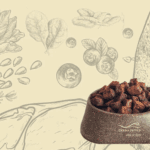As a dog parent, you’ve probably faced this moment: your dog has just finished their meal, licked the bowl clean… and is now staring at you with those irresistible puppy eyes. You ask yourself, “Is my dog still hungry—or just begging?” And while giving them a few extra treats feels like love, it can actually do more harm than good.
Let’s break it down and help you find the balance between satisfying your pup and keeping them healthy!
Is My Dog Really Hungry – Or Just Looking for More?
Dogs are natural scavengers, and many will eat whenever food is available—even if they’re not truly hungry. Here are some signs your dog might still be hungry:
Signs Your Dog Could Be Hungry:
- Finishing meals quickly and licking the bowl
- Weight loss or ribs becoming visible
- Low energy or lethargy
- Begging for food consistently at odd times
- Whining or pawing at their food bowl
Signs It’s Just a Habit or Attention-Seeking:
- Staring at you or your food during mealtimes
- Begging immediately after a full meal
- Sniffing around the kitchen or trash
- Looking at the treat jar with intent
If your dog is healthy, has a balanced diet, and is maintaining a good weight, chances are they’re not actually hungry—they just really love food!
How Many Treats Are Too Much?
Treats are a great way to reward good behavior and bond with your dog—but moderation is key. Too many treats can lead to:
- Weight gain
- Digestive upset
- Picky eating habits
- Nutritional imbalances
The 10% Rule
Veterinarians recommend that treats make up no more than 10% of your dog’s daily caloric intake. For example, if your dog needs 500 calories per day, only 50 of those should come from treats.
Tips for Healthy Treat Habits:
- Use low-calorie treats (or cut them into smaller pieces)
- Reward with praise or play instead of food when possible
- Factor treats into daily calorie intake
- Don’t feed human snacks unless they’re dog-safe (like plain carrots or apple slices in moderation)
Final Thoughts
Your dog’s love of food is part of their charm—but overfeeding, even with treats, can affect their long-term health. By learning to recognize true hunger cues and practicing mindful treating, you’ll keep your pup happy, healthy, and full of tail wags.
Remember: a healthy dog is a happy dog!






